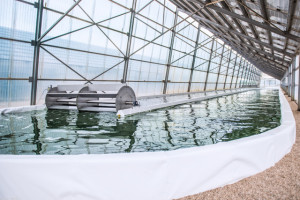The Horizon 2020 SPIRALG project is making the best of sustainably produced Spirulina biomass in the EU, from phycocyanin extracts to valuable co-products for improving human, animal and plant health.
SPIRALG is the very first micro-algae biomass project at a “Demonstrator level” funded by the Bio-Based Industry Joint Undertaking (BBI-JU) under the Horizon 2020 call. This very competitive Innovation Action call has been mainly funding new DEMO-plants able to transform and valorise large volumes of existing land-based biomass from agro-farming and forestry. The success of SPIRALG proposal in 2018 now indicates that micro-algae are progressively shifting from R&D scale to demonstrator scale able to prove economical viability. Indeed, SPIRALG is an opportunity to boost EU micro-algae production and to provide a variety of new valuable marketable bio-products in sufficient exploitable amounts in order to ensure an economically viable value chain.
The main goal of SPIRALG is to demonstrate that producing Spirulina biomass under sustainable and efficient conditions for phycocyanin extraction and potentially other valuable co-products, is economically viable. The main component of this value chain is the natural blue pigment phycocyanin which is expected to rapidly find markets in the food industry.
Phycocyanin, a natural blue dye

The natural blue dye, phycocyanin, has been recently approved by the FDA, in addition to the two existing synthetic blue dyes, Brilliant Blue (Blue 1) and Indigotine (Blue 2). The synthetic compounds, although approved since decades by the FDA, are undergoing discussions due to potential harmful effects such as toxicity, cancer and Attention Deficit Disorders (ADD).
In general terms, synthetic food dyes used in the food industry have reduced from 80 in the early 1900s to only 7 currently used today, and this due to human health issues. The growing concern of the public towards synthetic food ingredients has given way for the development of natural alternatives such as phycocyanin as proposed in this project.
Phycocyanin is a light harvesting pigment produced by a diversity of algal species as part of their internal photosystem. Like all primary producers, algae use these specific photosystems to convert solar-energy and atmospheric carbon to organic compounds (proteins, carbohydrates, lipids, pigments, vitamins…). Spirulina algae has been identified as a relevant species in terms of phycocyanin content, with values able to reach 20% under certain growth conditions.
What is sustainable about SPIRALG?

Extracting phycocyanin from algae biomass has multiple environmental benefits. Primarily, algae capture atmospheric carbon to metabolise organic compounds which will be extracted and then consumed, thereby recirculating carbon fluxes and reducing the impact on climate change. SPIRALG has selected appropriate regions for producing the algae (Sardinia, Italy) in order to reduce the use of artificial conditions (no artificial light and reduced warming) which are significant energy costs in the production process. Moreover, algae production plants do not need arable land and hence do not compete with conventional agriculture areas dedicated for food. In terms of process, phycocyanin is soluble in water-based eco-friendly solvents. Additionally, the biorefinery approach of SPIRALG has the aim of valorising the whole biomass and hence reducing waste.
A Life Cycle Assessment will be undertaken over the whole process composing the value chain, from biomass to end products, in order to measure environmental and societal impacts and to orientate industrial choices towards a more green and sustainable economy.
Major challenges
One of the main challenges of producing Spirulina biomass and extracting phycocyanin in the EU is to make the entire value chain economically viable and, in other terms, ensure that all end products are sufficiently competitive on the international market. The shift of conventional industrial practices towards greener economical choices will, most probably be in the future, a valuable criterion on the international scene. Therefore, in order to meet these economic and environmental challenges, SPIRALG will focus on increasing production efficiency, valorising the whole biomass (zero residues) and optimising processes with minimum inputs (eco-friendly technologies).
Also, it has been recognised that manufacturing is globally decreasing in the EU and patents are increasingly being exploited outside the EU. It is therefore a major societal challenge to modernize and develop new competitive and sustainable industrial concepts able to relocate production and transformation in the EU. Industrial biotechnology as described in this project SPIRALG is in line with the identified Key Enabling Technologies (KETs) supported by the EU and will hence contribute to the valorisation of knowledge towards marketable goods produced in the EU.
About SPIRALG
SPIRALG project is funded 5 million euros over a period of 4 years. The project is led by Jean Paul Cadoret, Managing Director of Greensea a French company specialised in Marine Biotechnologies. In addition to GreenSea, the consortium is composed of a Spirulina producing company in Italy (Milis Energy), algae-based ingredient producers (Algaia in France and MIAL in Germany) and LCA experts in the field (University College Dublin, Ireland). SPIRALG was officially launched in May 2018 by Greensea who hosted the kick-off meeting in the coastal town of Mèze (France). All consortium members were present along with the EU Scientific Project Officer, Dr Thomas Vizikas.
More info on www.spiralgaeproject.eu / www.bbi-europe.eu/projects
Text by Monique Ras


